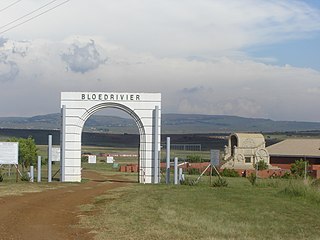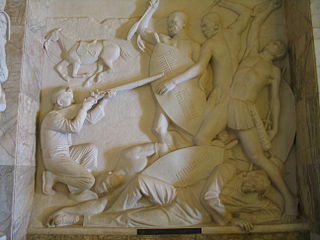
Uys is the surname of a family that played a significant role in South African history during the nineteenth century and made distinguished contributions to South African culture, politics and sports during the course of the twentieth.

Uys is the surname of a family that played a significant role in South African history during the nineteenth century and made distinguished contributions to South African culture, politics and sports during the course of the twentieth.
The earliest existing records show the Uys family living in Leiden and Amsterdam in the Netherlands.
The mother of the family's South African progenitor, Daentie Rycken (1645/46 – Stellenbosch 1725), was the first to arrive at the Cape in 1677 with her second husband, Jan Hendriksz de Lange (died Cape of Good Hope before June 1690). [1] [2] She briefly travelled to the Netherlands in 1697 with her third husband, Dirk Mol (died Stellenbosch 1731), and returned to the Cape in 1699 accompanied by her adult son, Cornelis Jansz Uys (Amsterdam 1671 – Cape of Good Hope c. 1716). [3] [4] Shortly thereafter, in 1704, Daentie settled on the farm By Den Weg in the Stellenbosch Kloof where she lived until her death in 1725. [5]
Cornelis Jansz Uys was the only child from Daentie Rycken's first marriage to the maritime carpenter Jan Cornelisz (Uys) (1641/42 – died Newcastle upon Tyne c. 1674). Cornelis was accompanied to the Cape by his wife, Dirkje Matthysdr (van) Westerhout (Leiden 1673 – Cape of Good Hope 1714), the niece of his mother's third husband. [6] [7] The couple established themselves in the heart of the Cape settlement on modern-day Strand Street. [8] [9]
In 1722 their only son, Dirk Cornelisz Uys (born Leiden 1698 – died Stellenbosch 1758), settled on the farm Groote Zalze in Stellenbosch, where he married Dina le Roux (Stellenbosch 1702 – Stellenbosch 1740), who was of Norman Huguenot descent, and played a distinguished role in the local community as farmer, deacon, elder, burgher officer and alderman. [10] [11] Dirk was also one of the first European pioneers in the Overberg area of the Cape. [12] The Uys family of southern Africa descend from this couple's three sons.
Two of the sons of Dirk Cornelisz Uys moved further into the interior of the Cape during the mid eighteenth century; [13] their progeny played a notable role in the history of the colony and enjoyed fame as a distinguished and progressive frontier dynasty. [14] The family also played a major role in the governance of the Dutch Republics in South Africa. [15] [16]
Genealogists have speculated that the name could be a variation of the French name de Louis or related to the Scottish island of Uist or perhaps a variation of the German name Husse. Reliable records do not exist to confirm any of these theories.
The Uys surname can also be used as a first name (generally in reference to an Uys descent through the distaff side), as is the case with the poet, writer and adventurer Uys Krige. A character in the novel Het Beloofde Land by Dutch author Adriaan van Dis also has this first name. [17]
The arms of the Uys family [18] are blazoned as:
Party per pale, in dexter vert three onions or in pale, in sinister argent a farmer standing on a stretch of grass holding a basket under his right arm proper.
These canting arms appear similar to those of the Van Uye family of Zeeland, to whom the Uys family are not related. [19] The Uys arms are differenced from the Van Uye arms by the basket which the farmer holds; in the Van Uye arms the farmer is holding a bunch of onions (French: "une glane d'oignons"). The onions (Dutch: ui) in the dexter half of the arms are a canting reference to the Uys family name.
These arms were presented to the Dutch-South African heraldist and genealogist Cornelis Pama in 1960 by J.W. Prinsloo née Uys who informed him that they had been found in old family documents. [20] Pama subsequently recorded these arms in his genealogical publications which led to their widespread dissemination and use by members of the Uys family. [21] The Rootenberg family who descend from an extra-marital branch of the Kapkamma Uyses also have a canting reference to onions in their arms. [22]

The Great Trek was a northward migration of Dutch-speaking settlers who travelled by wagon trains from the Cape Colony into the interior of modern South Africa from 1836 onwards, seeking to live beyond the Cape's British colonial administration. The Great Trek resulted from the culmination of tensions between rural descendants of the Cape's original European settlers, known collectively as Boers, and the British. It was also reflective of an increasingly common trend among individual Boer communities to pursue an isolationist and semi-nomadic lifestyle away from the developing administrative complexities in Cape Town. Boers who took part in the Great Trek identified themselves as voortrekkers, meaning "pioneers" or "pathfinders" in Dutch and Afrikaans.

The Boer republics were independent, self-governing republics formed by Dutch-speaking inhabitants of the Cape Colony and their descendants. The founders – variously named Trekboers, Boers, and Voortrekkers – settled mainly in the middle, northern, north-eastern and eastern parts of present-day South Africa. Two of the Boer republics achieved international recognition and complete independence: the South African Republic and the Orange Free State. The republics did not provide for the separation of church and state, initially allowing only the Dutch Reformed Church, and later also other Protestant churches in the Calvinist tradition. The republics came to an end after the Second Boer War of 1899–1902, which resulted in British annexation and later incorporation of their lands into the Union of South Africa.

The Battle of Blood River was fought on the bank of the Ncome River, in what is today KwaZulu-Natal, South Africa between 464 Voortrekkers ("Pioneers"), led by Andries Pretorius, and an estimated 25,000 to 30,000 Zulu. Estimations of casualties amounted to over 3,000 of King Dingane's soldiers dead, including two Zulu princes competing with Prince Mpande for the Zulu throne. Three Voortrekker commando members were lightly wounded, including Pretorius.
The year 1838 was the most difficult period for the Voortrekkers from when they left the Cape Colony, till the end of the Great Trek. They faced many difficulties and much bloodshed before they found freedom and a safe homeland in their Republic of Natalia. This was only achieved after defeating the Zulu Kingdom, at the Battle of Blood River, which took place on Sunday 16 December 1838. This battle would not have taken place if the Zulu King had honoured the agreement that he had made with the Voortrekkers to live together peacefully. The Zulu king knew that they outnumbered the Voortrekkers and decided to overthrow them and that led to the Battle of Blood River.

Joachim Johannes Ferreira was a Boer commandant of the First Boer War. This general J. Ferreira should not be confused with general I. Ferreira.
Gerhardus Jacobus Rudolph (1797–1851) was the grandson of the South African Rudolph progenitor, Johan Bernhard Rudolph.

Andries Hendrik Potgieter, known as Hendrik Potgieter was a Voortrekker leader. He served as the first head of state of Potchefstroom from 1840 and 1845 and also as the first head of state of Zoutpansberg from 1845 to 1852.

The Weenen massacre was the massacre of Voortrekkers, Khoikhoi and Basuto by the Zulu Kingdom on 17 February 1838. The massacres occurred at Doringkop, Bloukrans River, Moordspruit, Rensburgspruit and other sites around the present day town of Weenen in South Africa's KwaZulu-Natal province.
The following lists events that happened during 1837 in South Africa.

Swellendam is the third oldest town in South Africa, a town with 17,537 inhabitants situated in the Western Cape province. The town has over 50 provincial heritage sites, most of them buildings of Cape Dutch architecture. Swellendam is situated on the N2, approximately 220 km from both Cape Town and George.

Pieter Mauritz Retief was a Voortrekker leader. Settling in 1814 in the frontier region of the Cape Colony, he later assumed command of punitive expeditions during the sixth Xhosa War. He became a spokesperson for the frontier farmers who voiced their discontent, and wrote the Voortrekkers' declaration at their departure from the colony.

Dirk Cornelis "Dirkie" Uys was a Voortrekker hero during the Great Trek.

The Battle of Italeni took place in what is now KwaZulu Natal province, South Africa. It was fought between the Voortrekkers and the Zulus on 9 April 1838, during the period of the Great Trek.

Petrus Lafras Uys (1797–1838) was a Voortrekker leader during the Great Trek.

Richard Philip King (1811–1871) was an English trader and colonist at Port Natal, a British trading station in the region now known as KwaZulu-Natal. He is best known for a historic horseback ride in 1842, where he completed a journey of 960 kilometres (600 mi) in 10 days, to request help for the besieged British garrison at Port Natal. In recognition of his heroic deeds, a statue was unveiled in Durban portraying himself riding his horse 'Sunny’. Additionally, he was bestowed with an estate in Isipingo. Several prominent landmarks in Durban, including the Kings Park Rugby Stadium, Kingsmead Cricket Stadium, the former soccer stadium, and Kingsway High School, were named in his honour.

Hoërskool Voortrekker is a public Afrikaans medium co-educational high school situated in the municipality of Boksburg in the city of Ekurhuleni in the Gauteng province of South Africa. The academic school was established in 1920.
Christoffel van IJsselstein was the illegitimate son of Frederik of Egmont, Count of Buren and Leerdam, Lord of IJsselstein, and an unknown mother.
Jan Gerritze Bantjes was a Voortrekker whose exploration of the Natal and subsequent report were the catalyst for mobilising the Great Trek. He was also the author of the treaty between the Zulu king Dingane kaSenzangakhona and the Voortrekkers under Andries Pretorius.
Marthinus Jacobus Oosthuizen was a Voortrekker farmer known for his heroism in battle.

Martha Mabel Jansen, DMS was a South African educator, writer, journalist, cultural leader, politician and pioneer in the promotion of Afrikaans, as well as the spouse of the penultimate Governor-General of the Union of South Africa, E.G. Jansen.
The Pietermaritzburg Reformed Church was a congregation of the Dutch Reformed Church in South Africa (NGK) in Pietermaritzburg, the capital of KwaZulu-Natal, but after the sale of the congregation’s downtown building, its centre shifted to what is now Howick. It was the first congregation founded by Voortrekkers after they left Cape Colony and the 25th oldest congregation in the NGK. The congregation’s membership, however, declined by around two-thirds, from 752 in 2000 to 256 in 2015.